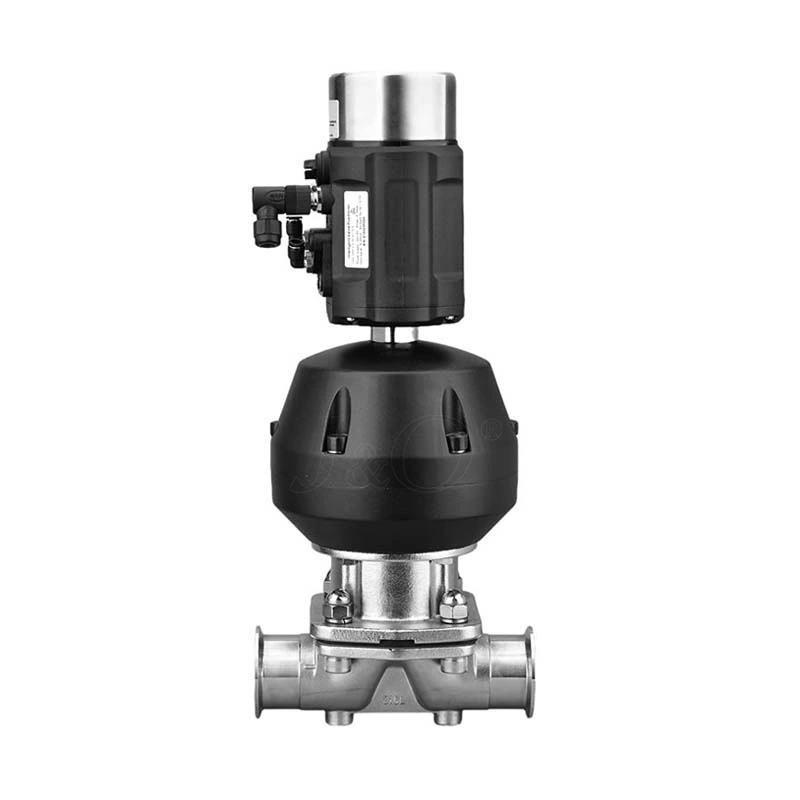Analysis Of Common Problems Of Pneumatic Diaphragm Valves
Sanitary Diaphragm Valve Common faults
I. Faults in the air source system
1. Blockage of the instrument air line. Since the ball valve has a throttling effect at the end of the instrument branch air line, the dirt in the air line is easy to accumulate and block here. As a result, the instrument air pressure is too low, the regulating valve cannot be fully opened or fully closed, or even the regulating valve does not move.
2. Fault of the air filter pressure reducing valve. The air filter pressure reducing valve has been used for a long time and there are too many dirt, the pressure reducing valve leaks, and the output pressure of the pressure reducing valve is set too low, so that the output instrument air pressure is less than the specified pressure. The regulating valve moves slowly, cannot be fully opened or fully closed, or even does not move.
3. Fault in the copper pipe connection. The copper pipe is aging and leaking, the joint connection is loose, or the dirt blocks the copper pipe, causing the instrument signal air pressure to be low, causing the regulating valve to not move, cannot be fully opened or fully closed, and the manual state valve position is unstable, resulting in regulation oscillation.
4. Fault in the instrument air system. The air compressor station is abnormal, the purification air tank of the device is abnormal, the water is not cut in time to freeze the air line, the instrument air line leaks or is blocked by stolen goods, resulting in the device instrument air pressure being too low or even no wind. 5. The valve of the instrument air branch line is not opened, causing the regulating valve to not work. It often occurs during the overhaul of the device and the start-up period after the transformation.
2. Power supply system failure
1. The power line terminal is loose, short-circuited, detached, and the connection is reversed. Due to the vibration on the site, the wiring is loose or too much dust causes poor contact, so that the signal from the control room to the site is sometimes there, causing the regulating valve to operate chaotically and produce regulation oscillation. Due to wiring errors, water inflow or moisture in the equipment, the power line connection is short-circuited, so that the signal received by the regulating valve is lower than the signal of the regulator, causing the regulating valve to be unable to fully open and close. The regulating valve does not work due to detachment and reverse connection. Reverse connection often occurs when installing a new meter, rewiring, overhauling the device, etc.
2. Failure of the middle joint or the middle injury of the power line. The power cord is subject to environmental vibration, external force pulling, insulation tape failure, reduced insulation performance, and water ingress and high temperature baking of the joints, which causes the power cord connector to become loose or seemingly broken, short circuit between power cords or short circuit to the ground, and the terminal or power cord is broken. This causes the regulating valve to act discontinuously, cannot be fully opened or fully closed, and does not act. During the maintenance process, the middle connector of the power cord is connected in reverse, causing the regulating valve to not act.
3. The regulating valve is not controlled by the regulator. During the overhaul and start-up of the device after the transformation, the power cord is connected incorrectly or the configuration in the control room is wrong, causing the regulating valve to not be controlled by the regulator.
III. Electrical converter failure
1. Inaccurate zero point and range. Due to inaccurate installation and commissioning or on-site vibration, temperature changes, etc., the zero point and range of the converter output signal are inaccurate. This causes the regulating valve to be unable to fully open or fully close, large leakage, * and other phenomena. In the on-site adjustment of the converter, the converter signal meter should first ensure that the indication is accurate. The signal meter should be maintained normally.
2. The throttle hole is blocked. The instrument wind dirt blocks the throttle hole. The regulating valve does not work.
3. The output is not linear. Due to the aging of the coils and components in the converter or the influence of on-site vibration and ambient temperature, the output of the converter is not linear, so that the required value cannot be reached during the zero point and range adjustment process, and the regulating valve does not work linearly and cannot be fully opened or closed.
